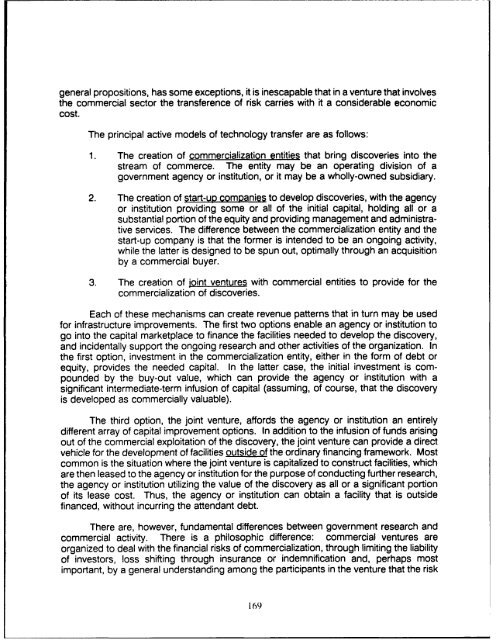Challenges and Opportunities for Innovation in the Public Works ...
Challenges and Opportunities for Innovation in the Public Works ...
Challenges and Opportunities for Innovation in the Public Works ...
You also want an ePaper? Increase the reach of your titles
YUMPU automatically turns print PDFs into web optimized ePapers that Google loves.
general propositions, has some exceptions, it is <strong>in</strong>escapable that <strong>in</strong> a venture that <strong>in</strong>volves<br />
<strong>the</strong> commercial sector <strong>the</strong> transference of risk carries with it a considerable economic<br />
cost.<br />
The pr<strong>in</strong>cipal active models of technology transfer are as follows:<br />
1. The creation of commercialization entities that br<strong>in</strong>g discoveries <strong>in</strong>to <strong>the</strong><br />
stream of commerce. The entity may be an operat<strong>in</strong>g division of a<br />
government agency or <strong>in</strong>stitution, or it may be a wholly-owned subsidiary.<br />
2. The creation of start-up companies to develop discoveries, with <strong>the</strong> agency<br />
or <strong>in</strong>stitution provid<strong>in</strong>g some or all of <strong>the</strong> <strong>in</strong>itial capital, hold<strong>in</strong>g all or a<br />
substantial portion of <strong>the</strong> equity <strong>and</strong> provid<strong>in</strong>g management <strong>and</strong> adm<strong>in</strong>istrative<br />
services. The difference between <strong>the</strong> commercialization entity <strong>and</strong> <strong>the</strong><br />
start-up company is that <strong>the</strong> <strong>for</strong>mer is <strong>in</strong>tended to be an ongo<strong>in</strong>g activity,<br />
while <strong>the</strong> latter is designed to be spun out, optimally through an acquisition<br />
by a commercial buyer.<br />
3. The creation of io<strong>in</strong>t ventures with commercial entities to provide <strong>for</strong> <strong>the</strong><br />
commercialization of discoveries.<br />
Each of <strong>the</strong>se mechanisms can create revenue patterns that <strong>in</strong> turn may be used<br />
<strong>for</strong> <strong>in</strong>frastructure improvements. The first two options enable an agency or <strong>in</strong>stitution to<br />
go <strong>in</strong>to <strong>the</strong> capital marketplace to f<strong>in</strong>ance <strong>the</strong> facilities needed to develop <strong>the</strong> discovery,<br />
<strong>and</strong> <strong>in</strong>cidentally support <strong>the</strong> ongo<strong>in</strong>g research <strong>and</strong> o<strong>the</strong>r activities of <strong>the</strong> organization. In<br />
<strong>the</strong> first option, <strong>in</strong>vestment <strong>in</strong> <strong>the</strong> commercialization entity, ei<strong>the</strong>r <strong>in</strong> <strong>the</strong> <strong>for</strong>m of debt or<br />
equity, provides <strong>the</strong> needed capital. In <strong>the</strong> latter case, <strong>the</strong> <strong>in</strong>itial <strong>in</strong>vestment is compounded<br />
by <strong>the</strong> buy-out value, which can provide <strong>the</strong> agency or <strong>in</strong>stitution with a<br />
significant <strong>in</strong>termediate-term <strong>in</strong>fusion of capital (assum<strong>in</strong>g, of course, that <strong>the</strong> discovery<br />
is developed as commercially valuable).<br />
The third option, <strong>the</strong> jo<strong>in</strong>t venture, af<strong>for</strong>ds <strong>the</strong> agency or <strong>in</strong>stitution an entirely<br />
different array of capital improvement options. In addition to <strong>the</strong> <strong>in</strong>fusion of funds aris<strong>in</strong>g<br />
out of <strong>the</strong> commercial exploitation of <strong>the</strong> discovery, <strong>the</strong> jo<strong>in</strong>t venture can provide a direct<br />
vehicle <strong>for</strong> <strong>the</strong> development of facilities outside of <strong>the</strong> ord<strong>in</strong>ary f<strong>in</strong>anc<strong>in</strong>g framework. Most<br />
common is <strong>the</strong> situation where <strong>the</strong> jo<strong>in</strong>t venture is capitalized to construct facilities, which<br />
are <strong>the</strong>n leased to <strong>the</strong> agency or <strong>in</strong>stitution <strong>for</strong> <strong>the</strong> purpose of conduct<strong>in</strong>g fur<strong>the</strong>r research,<br />
<strong>the</strong> agency or <strong>in</strong>stitution utiliz<strong>in</strong>g <strong>the</strong> value of <strong>the</strong> discovery as all or a significant portion<br />
of its lease cost. Thus, <strong>the</strong> agency or <strong>in</strong>stitution can obta<strong>in</strong> a facility that is outside<br />
f<strong>in</strong>anced, without <strong>in</strong>curr<strong>in</strong>g <strong>the</strong> attendant debt.<br />
There are, however, fundamental differences between government research <strong>and</strong><br />
commercial activity. There is a philosophic difference: commercial ventures are<br />
organized to deal with <strong>the</strong> f<strong>in</strong>ancial risks of commercialization, through limit<strong>in</strong>g <strong>the</strong> liability<br />
of <strong>in</strong>vestors, loss shift<strong>in</strong>g through <strong>in</strong>surance or <strong>in</strong>demnification <strong>and</strong>, perhaps most<br />
important, by a general underst<strong>and</strong><strong>in</strong>g among <strong>the</strong> participants <strong>in</strong> <strong>the</strong> venture that <strong>the</strong> risk<br />
169







